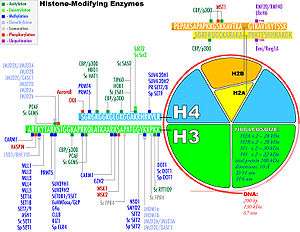Histone-modifying enzymes
The packaging of the eukaryotic genome into highly condensed chromatin makes it inaccessible to the factors required for gene transcription, DNA replication, recombination and repair. Eukaryotes have developed intricate mechanisms to overcome this repressive barrier imposed by the chromatin. The nucleosome is composed of an octamer of the four core histones (H3, H4, H2A, H2B) around which 146 base pairs of DNA are wrapped. Several distinct classes of enzyme can modify histones at multiple sites.[1] The figure on the right enlists those histone-modifying enzymes whose specificity has been determined. There are at least eight distinct types of modifications found on histones (see the legend box on the top left of the figure). Enzymes have been identified for acetylation,[2] methylation,[3] demethylation,[4] phosphorylation,[5] ubiquitination,[6] O-GlcNAcylation,[7] sumoylation,[8] ADP-ribosylation,[9] deimination,[10][11] and proline isomerization.[12] For a detailed example of histone modifications in transcription regulation see RNA polymerase control by chromatin structure and table "Examples of histone modifications in transcriptional regulation". Different physiological changes (e.g. deficiency of vitamin B12, etc.) are known to be associated with behavioural changes.[13][14] In a 2009 review article,[15] authors have summarized different studies of the histone acetyltransferases (HATs) p300 and Rtt109 (KAT11), and the histone lysine demethylases (HDMs) LSD1 (KDM1) and JMJD2A (KDM4A). Additionally, recent evidences show the importance of HDACs in regulation of lipid metabolism and other metabolic pathways playing role in the pathophysiology of metabolic disorders.[16]

See also
References
- Kouzarides T (February 2007). "Chromatin modifications and their function". Cell. 128 (4): 693–705. doi:10.1016/j.cell.2007.02.005. PMID 17320507.
- Sterner DE, Berger SL (June 2000). "Acetylation of histones and transcription-related factors". Microbiol. Mol. Biol. Rev. 64 (2): 435–59. doi:10.1128/MMBR.64.2.435-459.2000. PMC 98999. PMID 10839822.
- Zhang Y, Reinberg D (2001). "Transcription regulation by histone methylation: interplay between different covalent modifications of the core histone tails". Genes Dev. 15 (18): 2343–60. doi:10.1101/gad.927301. PMID 11562345.
- Klose RJ, Zhang Y (2007). "Regulation of histone methylation by demethylimination and demethylation". Nat. Rev. Mol. Cell Biol. 8 (4): 307–18. doi:10.1038/nrm2143. PMID 17342184.
- Nowak SJ, Corces VG (April 2004). "Phosphorylation of histone H3: a balancing act between chromosome condensation and transcriptional activation". Trends Genet. 20 (4): 214–20. doi:10.1016/j.tig.2004.02.007. PMID 15041176.
- Shilatifard A (2006). "Chromatin modifications by methylation and ubiquitination: implications in the regulation of gene expression". Annu. Rev. Biochem. 75: 243–69. doi:10.1146/annurev.biochem.75.103004.142422. PMID 16756492.
- K, Sakabe; Z, Wang; Gw, Hart (2010-11-16). "Beta-N-acetylglucosamine (O-GlcNAc) Is Part of the Histone Code". Proceedings of the National Academy of Sciences of the United States of America. PMID 21045127. Retrieved 2020-06-01.
- Nathan D, Ingvarsdottir K, Sterner DE, et al. (April 2006). "Histone sumoylation is a negative regulator in Saccharomyces cerevisiae and shows dynamic interplay with positive-acting histone modifications". Genes Dev. 20 (8): 966–76. doi:10.1101/gad.1404206. PMC 1472304. PMID 16598039.
- Hassa PO, Haenni SS, Elser M, Hottiger MO (September 2006). "Nuclear ADP-ribosylation reactions in mammalian cells: where are we today and where are we going?". Microbiol. Mol. Biol. Rev. 70 (3): 789–829. doi:10.1128/MMBR.00040-05. PMC 1594587. PMID 16959969.
- Cuthbert GL, Daujat S, Snowden AW, et al. (September 2004). "Histone deimination antagonizes arginine methylation". Cell. 118 (5): 545–53. doi:10.1016/j.cell.2004.08.020. PMID 15339660.
- Wang Y, Wysocka J, Sayegh J, et al. (October 2004). "Human PAD4 regulates histone arginine methylation levels via demethylimination". Science. 306 (5694): 279–83. Bibcode:2004Sci...306..279W. doi:10.1126/science.1101400. PMID 15345777.
- Nelson CJ, Santos-Rosa H, Kouzarides T (September 2006). "Proline isomerization of histone H3 regulates lysine methylation and gene expression". Cell. 126 (5): 905–16. doi:10.1016/j.cell.2006.07.026. PMID 16959570.
- Ghosh, Shampa; Sinha, Jitendra Kumar; Khandelwal, Nitin; Chakravarty, Sumana; Kumar, Arvind; Raghunath, Manchala (2018-11-25). "Increased stress and altered expression of histone modifying enzymes in brain are associated with aberrant behaviour in vitamin B12 deficient female mice". Nutritional Neuroscience. 0: 1–10. doi:10.1080/1028415X.2018.1548676. ISSN 1028-415X. PMID 30474509.
- Saraswathy, Kallur Nava; Ansari, Shagufta Naaz; Kaur, Gurjinder; Joshi, Pooran Chand; Chandel, Shivani (April 2019). "Association of vitamin B12 mediated hyperhomocysteinemia with depression and anxiety disorder: A cross-sectional study among Bhil indigenous population of India". Clinical Nutrition ESPEN. 30: 199–203. doi:10.1016/j.clnesp.2019.01.009. ISSN 2405-4577. PMID 30904222.
- Marmorstein, Ronen; Trievel, Raymond C. (January 2009). "Histone Modifying Enzymes: Structures, Mechanisms, and Specificities". Biochimica et Biophysica Acta (BBA) - Gene Regulatory Mechanisms. 1789 (1): 58–68. doi:10.1016/j.bbagrm.2008.07.009. ISSN 0006-3002. PMC 4059211. PMID 18722564.
- A, Ferrari; E, Fiorino; M, Giudici; F, Gilardi; A, Galmozzi; N, Mitro; G, Cermenati; C, Godio; D, Caruso (November 2012). "Linking Epigenetics to Lipid Metabolism: Focus on Histone Deacetylases". Molecular Membrane Biology. 29 (7): 257–66. doi:10.3109/09687688.2012.729094. PMID 23095054.